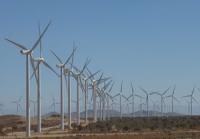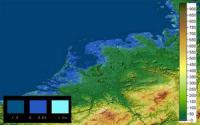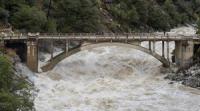-
Radioactivity from oil, gas wastewater persists in Pennsylvania stream sediments
More than seven years after Pennsylvania officials requested that the disposal of radium-laden fracking wastewater into surface waters be restricted, a new study finds. The contamination is coming from the disposal of conventional, or non-fracked, oil and gas wastewater, which, under current state regulations, can still be treated and discharged to local streams.
-
-
Thorium reactors could dispose of large amounts of weapons-grade plutonium
Scientists are developing a technology enabling the construction of high-temperature, gas-cool, low-power reactors with thorium fuel. The scientists propose to burn weapons-grade plutonium in these units, converting it into power and thermal energy. Thermal energy generated at thorium reactors may be used in hydrogen industrial production. The technology also makes it possible to desalinate water.
-
-
Interconnected technological risks: Responding to disruptions of cyber-physical systems
When infectious diseases strike, the World Health Organization acts swiftly, coordinating with the U.S. Centers for Disease Control and Prevention and its foreign counterparts to contain the threat. But there is no equivalent international organization similarly dedicated to identifying and mitigating a cyberattack. The World Economic Forum (WEF), however, is bringing together infrastructure and technology developers, insurers and government officials from across the globe to develop strategies for responding to interconnected technological risks, including those that can cascade when hackers disrupt cyber-physical systems.
-
-
2018: Critical period of intensified risks
The Global Risks Report 2018, published this week by the World Economic Forum cautions that we are struggling to keep up with the accelerating pace of change. It highlights numerous areas in which we are pushing systems to the brink, from extinction-level rates of biodiversity loss to mounting concerns about the possibility of new wars. The reports says that the structural and interconnected nature of risks in 2018 threatens the very system on which societies, economies, and international relations are based – but that the positive economic outlook gives leaders the opportunity to tackle systemic fragility.
-
-
Onshore wind power as affordable now as any other source; cost of solar to halve by 2020

The cost of generating power from onshore wind has fallen by around a quarter since 2010, with solar photovoltaic (PV) electricity costs falling by 73 percent in that time, according to new cost analysis from the International Renewable Energy Agency (IRENA). The report also highlights that solar PV costs are expected to halve by 2020. The best onshore wind and solar PV projects could be delivering electricity for an equivalent of 3 cents per kilowatt hour (kWh), or less within the next two years.
-
-
The bonus effects of California's water saving
Measures to cut water use by 25 percent across California were implemented in 2015, following a four-year drought in the state that caused the fallowing of 542,000 acres of land, total economic costs of $2.74 billion, and the loss of approximately 21,000 jobs. The UC Davis researchers found that, while the 25 percent target had not quite been reached over the one-year period — with 524,000 million gallons of water saved — the measures’ impact had positive knock-on effects for other environmental objectives, leading to substantial reductions in greenhouse gas (GHG) emissions and electricity consumption in the state.
-
-
2017 saw the highest ever sea level on the Dutch coast

The average sea level measured on the Dutch coast was higher than ever before in 2017. The Dutch sea level, the averaged measurements from six tide stations, rose to 11 cm above Normal Amsterdam Water Level (NAP in Dutch). The last highest measurement was in 2007, when the average sea level was 9 cm above NAP. The fact that the sea level was higher last year does not mean that the sea level is now rising faster. At present, the sea level on the Dutch coast is rising by 20 cm every century.
-
-
River flood risks increase around the globe under future warming

Rainfall changes caused by global warming will increase river flood risks across the globe. Already today, fluvial floods are among the most common and devastating natural disasters. Scientists have now calculated the required increase in flood protection until the 2040s worldwide, breaking it down to single regions and cities. They find that the need for adaptation is greatest in the United States, parts of India and Africa, Indonesia, and in Central Europe including Germany. Inaction would expose many millions of people to severe flooding.
-
-
Climate change changing Earth’s landscape

Climate change will replace land use change as the major driver of changes in Earth’s biosphere in the twenty-first century if greenhouse gas emissions aren’t curbed, new research suggests. Historically, human land use change, like urban development and agricultural expansion, has been the primary cause of anthropogenic ecosystem change. But now, due to rising greenhouse gas levels, climate change has become a growing threat to ecosystems. The rapid pace of climate change is making it difficult for species to adapt to changes in temperature, water cycles, and other environmental conditions that affect life on Earth.
-
-
Rejection of subsidies for coal and nuclear power is a win for fact-based policymaking
Energy Secretary Rick Perry has repeatedly expressed concern over the past year about the reliability of our national electric power grid. On 28 September 2017, Perry ordered the Federal Energy Regulatory Commission (FERC) to revise wholesale electricity market rules, implicitly suggesting that the federal government would give subsidies to owners of coal and nuclear power plants, to compensate them for keeping a 90-day fuel supply on-site in the event of a disruption to the grid. On Monday, the independent five-member commission – four of whose members have been appointed by President Trump — unanimously rejected Perry’s proposal. FERC’s 5-0 decision shows that policymaking based on evidence won the day. Perry’s proposal, which critics said was aiming to prop up nuclear and coal power plants struggling in competitive electricity markets, had the potential to affect millions of electricity customers, as well as power markets and the environment. FERC deserves congratulations for putting evidence before action.
-
-
2017 climate, weather disasters in U.S. totaling $306 billion — a new record
2017 will be remembered as a year of extremes for the United States as floods, tornadoes, hurricanes, drought, fires, and freezes claimed hundreds of lives and visited economic hardship upon the nation. The average U.S. temperature in 2017 was 54.6 degrees F (2.6 degrees F above average), making 2017 third warmest year in 123 years of record-keeping. The five warmest years on record for the United States all have occurred since 2006. In 2017, the United States experienced 16 weather and climate disasters each with losses exceeding $1 billion, totaling approximately $306 billion — a new U.S. record. Far more tragic was the human toll. At least 362 people died and many more were injured during the course of these disasters.
-
-
Studying climate effects on California water systems from headwaters to groundwater
To address future climate change effects on water resources, scientists at five UC campuses, and Lawrence Livermore and Lawrence Berkeley national laboratories, will study California’s water systems, from the headwaters in the Sierra Nevada, through rivers, reservoirs and groundwater in the Central Valley. The project will allow scientists to examine hydrologic sensitivities of California headwaters and agricultural demand to changing climate and will consider plausible societal adaptations.
-
-
With storms intensifying and oceans on the rise, Boston weighs strategies for staying dry
As this year’s hurricanes marched across the Caribbean into the Gulf Coast or out to the North Atlantic, cities along the U.S. northeastern coast knew they were dodging bullets. If Boston gets hit by a storm like Hurricane Harvey, mayor Marty Walsh acknowledged in a radio interview, “we are wiped out as a city.” An MIT analysis suggests that a Category 1 hurricane with a few feet of surge on top of a high tide could flood a quarter of a million Boston residents. And climate change is bringing more intense storms and rising tides. A multi-billion-dollar seawall is among climate adaptation options under consideration for the iconic coastal city.
-
-
Innovative smart grid technology solves decades-old problematic power grid phenomenon
Picture a teeter-totter gently rocking back and forth, one side going up while the other goes down. When electricity travels long distances, it starts to behave in a similar fashion: the standard frequency of 60 cycles per second increases on the utility side of the transmission line while the frequency on the customer side decreases, switching back and forth every second or two. This phenomenon — called inter-area oscillations — can be a problem on hot summer days when the demand for power is high. Sandia National Laboratories and partners have demonstrated a control system that smooths out these oscillations using new smart grid technology. Sandia’s controls use real-time data to reduce inter-area oscillations on western grid.
-
-
Self-healing microgrids to help keep isolated Cordova, Alaska, cope with disasters, cyberattacks
Cordova, Alaska, is in a far-flung nook of Prince William Sound. There are no roads connecting Cordova with the rest of the world. The only way to get there is by plane or boat. The city’s electrical grid is also isolated; there’s no physical connection to the outside world. The situation is compounded by harsh weather and a mix of hydroelectric, diesel and solar power generation, with a seasonal consumer demand that changes significantly throughout the year. In the event of a major natural disaster, such as the Great Alaska Earthquake of 1964, Cordova might be completely cut off. A system of microgrids would enhance grid resilience by maintaining and restoring power after a catastrophic event or a cyberattack.
-
More headlines
The long view
Helping Strengthen America’s Critical Infrastructure
Everyday life depends on a robust infrastructure network that provides access to running water, communications technology and electricity, among other basic necessities. The experts who keep our national infrastructure secure and resilient also need a strong network to share their knowledge and train the next generation of professionals capable of solving complex infrastructure challenges.
AI and the Future of the U.S. Electric Grid
Despite its age, the U.S. electric grid remains one of the great workhorses of modern life. Whether it can maintain that performance over the next few years may determine how well the U.S. competes in an AI-driven world.
Using Liquid Air for Grid-Scale Energy Storage
New research finds liquid air energy storage could be the lowest-cost option for ensuring a continuous power supply on a future grid dominated by carbon-free but intermittent sources of electricity.
Enhanced Geothermal Systems: A Promising Source of Round-the-Clock Energy
With its capacity to provide 24/7 power, many are warming up to the prospect of geothermal energy. Scientists are currently working to advance human-made reservoirs in Earth’s deep subsurface to stimulate the activity that exists within natural geothermal systems.
Experts Discuss Geothermal Potential
Geothermal energy harnesses the heat from within Earth—the term comes from the Greek words geo (earth) and therme (heat). It is an energy source that has the potential to power all our energy needs for billions of years.
